

  |
|
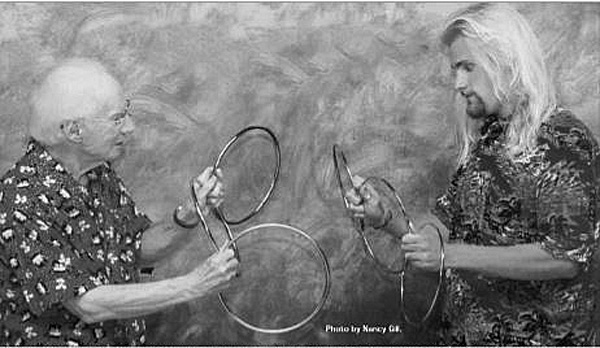
|
Name: Scottsville's Old Magic by Ruth Klippstein Date: October 2011 Image Number: RK17cdRK02 Comments: Let's dream up some smalltown Saturday mornings in the late 1940s, early '50s. The war is over, restrictions and rationing eased, and though nothing will be the same again, children run and play on tree-lined streets with a new prosperity and optimism in the air. Picture Scottsville, see Harrison Street. Those children have been dropped by their parents: "A regular parade of cars came across Harrison Street," Bob Spencer (aka Kirkwood the Magician) now recounts; "the parents were delighted" to be leaving their charges at his door from ten to noon, paying a small fee, "a few cents or a nickel or dime," remembers Donald Combs, for home movies, music, and magic. "It was quite a big thing, I thought," says Bob. 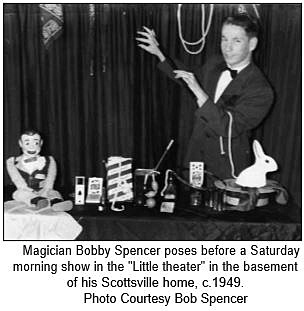 "I can remember going to the shows," recounts Baxter Pitts. "We lived in the downstairs apartment where the Sesame Seed store was, so I just walked up the hill behind it to attend. I was only six or seven, but I remember him doing tricks." "I used to be a faithful attendee," says Bill Mason. "Bobby Spencer had a stage, about a dozen chairs; it was a big deal, and always pretty authentic." Boy Wizard "Bobby Spencer, Boy Wizard and Company" created a little theater in his basement, and Spencer's life in magic had begun. "Bobby always seemed to have a flair for entertainment," says Combs, one of his assistants. On October 22, 2011, Bob will celebrate his 65th year in magic with a special presentation at Victory Hall Theatre. It started with an assembly show at Scottsville High School when Spencer was in third grade in 1944. There he saw The Shrimplins, a husband and wife team of magicians, and was galvanized. This only child of Kirk and Louise Pitts Spencer, who wanted to be a teacher and preacher--who practiced preaching to captive friends and adults--determined that he, too, would make magic. 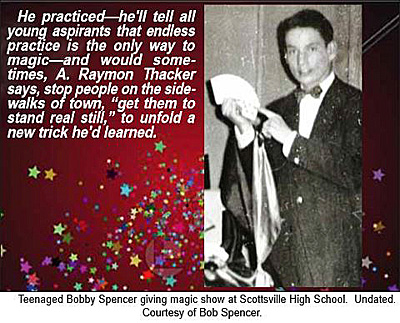 Bob had also identified the deep strain of theatrical interest in his make-up by this time. "Whenever a play presented by a high school drama group required 'a little brat' in the cast, I was the chosen one," he has written. He had, as well, begun to haunt Victory Theatre in Scottsville, home of Chautauqua acts, popular singers, and regular movie showings. Eventually he became a ticket-taker and usher, cementing a life-long commitment to the building. Combs, too, was a ticket-taker--and the wages, he notes, were free admission to all the movies. A "Blackstone, Master Magician" comic, which Bob bought as well as a Gilbert Mysto Magic Set from Christmas 1945, sent Bob on his way. He practiced--he'll tell all young aspirants that endless practice is the only way to magic-and would sometimes, A. Raymon Thacker says, stop people on the sidewalks of town, "get them to stand real still," to unfold a new trick he'd learned for the faculty at Fork Union Military Academy, where he taught English and organized social and entertainment events on campus. He stayed at FUMA for 34 years, performing many jobs. "My true life's work, combining the ministry, teaching, journalism, and entertainment," he writes. 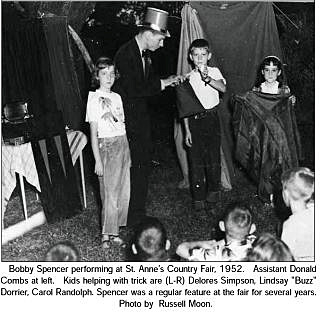 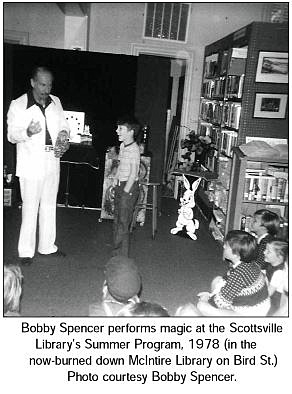 James "Nip" Chisholm, who reminds us he was "very young in the '40s," recalls the 30-cent lunch in town: two hot dogs and a Pepsi. Lucky Strike cigarettes were 17 cents a pack and many of the older boys smoked behind the bleachers on the baseball field, near the current levee. Nip lived 12 miles away, in the Woodridge area, and recalls walking to town to go to the dentist. This is a true story. Chub Walsh remembers an even less expensive lunch: hot dog, Coke, and an ice cream cone, scooped up right by the door, at Lee's, for 15 cents. Lee always told the school kids as they left, "God bless you." Many students came in from the surrounding countryside, Walsh says; he had cousins at Green Mountain, who walked three miles to catch the school bus. Some would do their family grocery shopping during lunch hour or take produce grown in home gardens to sell to a grocery store. "Not everybody had a car." Walsh quit high school one day in 1948 and the next was in the Navy. Gene Harding credits the high school with making the community, giving it a sense of cohesion, and the loss of it, in 1967, with "the end of the town" and all the thriving locally-owned businesses. Saturday evenings, after workers had been paid, "I can remember it was like walking down Broadway. You'd have to step off the sidewalk into the road to get around, that's how thick it was with people. You'd wait in line at night" to get into Bruce's for a fountain soda. Gene, too, remembers young people smoking. "But not on school grounds. Billy Pitts, at six years old, would stop at the fence around the school (where the library is now) and knock out his pipe on the gatepost, refilling it for the trip home." True story? The Old Days Bill Mason further describes the era by saying there would be no one left on the streets if there was a home baseball game on Sunday and that on the grounds near the diamond was still a blacksmith shop, where people using horses and buggies came for service. He remembers rollerskating up and down the sidewalks at night, taking a break and sitting on the recently reopened corner entrance of Dorrier's general store. As an older teen, Bill played golf on the four-hole course established at the Rubber Plant, along with a public tennis court, and touch football games on the grass there. He, Dave Catlett, and Don Combs, after their Saturday morning sports, would go to Roy Hamner's shop in the now-empty area next to the old post office, where Roy would be doing mechanical repairs. The boys, perching on John Deere tractors sold by the Meltons and eating nickel peanuts and drinking Coke from the machines, would listen every week with him to the "top-notch UVA football" games on the radio. Bill remembers even earlier games at the other end of town, East Main Street, where the C&O railroad maintained what was called "The Park" between the depot and the tracks roughly in the area where James River Reeling and Rafting is now. The park was established at least by 1918, when his mother came to town, and was very popular. "Anybody who lived on the east end of town played there--a dozen or 15 people at a time for baseball, touch football, and mostly hide-and-seek, kick-the-can. My parents must have had nerves of steel," Mason now recounts, to let him play so close to the tracks and hide under the railroad cars, but the area was kept very nicely with hedges well trimmed. "We had more fun there," Mason remembers, fondly recalling the "East End Gang," including Sarah Porter's grandson, Abraham Coles, Arthur and Sonny Thacker, Maynard Stinson, Ralph McGuire, and the Bryant brothers. Larry Stallings worked at Bruce's Drug Store one summer in the '40s, doing "general police work, managing," he says. "Town was busy, there was the movie, always something going on." Bruce's closed at 9 pm, after people had had a chance to walk around and get a soda. The baseball games "were a big thing," too. Larry recalls that at the first one he attended Skinny Spradlin hit a ball across Main Street to the Harris house (across from the former post office). "That was a home run!" Larry returned to Scottsville High School after serving in the Navy, 1945-47. He says there were "several vets, and we were kind of lionized. Veterans had a little degree of prestige then." By the mid-1950s, the Scottsville phonebook still needed to describe how to make a call without, since 1952, Central to help. "Hold the receiver to your ear" was one tip. Tom Allison was teaching agriculture at the high school, where there were only three upper grades. A photo of a girl in flannel-cuffed blue jeans inspired the comment "Is it a boy?!" in the yearbook. The students attended a Rally Day with other country high schools at UVA, competing in track and field, volleyball, dodgeball, and other events for a trophy. 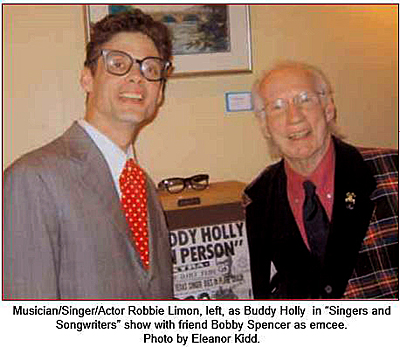 Somewhere out on the road, Jack Kerouac would write in 1957, "Where we going, man? I don't
know, but we gotta go." Help Kirkwood (Bobby) Spencer celebrate this long trip with his 65th anniversary in magic, Saturday, October 22,
2011, at Victory Hall Theatre, with two performances, including a host of guest magicians.
Somewhere out on the road, Jack Kerouac would write in 1957, "Where we going, man? I don't
know, but we gotta go." Help Kirkwood (Bobby) Spencer celebrate this long trip with his 65th anniversary in magic, Saturday, October 22,
2011, at Victory Hall Theatre, with two performances, including a host of guest magicians.
|
|
|
|
Museum
Archive
Business
Cemeteries
Church
Events
Floods
For Kids
Homes
Portraits
Postcards
School
Transportation
Civil War WWII Esmont Search Policy |
||||
|
Scottsville Museum · 290 Main Street · Scottsville, Virginia 24590 · 434-286-2247 www.avenue.org/smuseum · info@scottsvillemuseum.com Copyright © 2020 by Scottsville Museum |
||||